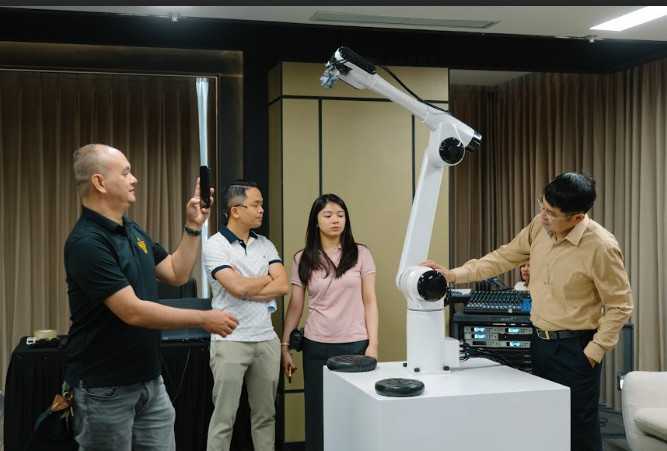"When I first said I wanted to build a robotic arm, almost no one understood my ambition. Some even laughed, doubting the value or feasibility of such a product," said Huu Trung, CEO of ELBOT.
From dismissed dream to made-in-Vietnam reality

The ELBOT robot arm is crafted from solid steel and cast aluminum with modular design, 1,310mm reach, and ±0.1mm accuracy. Photo: PV
Vietnam has long been a growing hub for electronics, precision mechanics, and auto assembly, making it fertile ground for robotic arm technology.
Experts believe that integrating robotic arms with digital transformation and AI could enhance Vietnam’s manufacturing competitiveness, labor quality, and product standards.
Among the most common types of robots in modern automation, robotic arms (with 3 to 7 degrees of freedom) are used globally in sectors ranging from logistics to industrial manufacturing.
Countries like South Korea, Singapore, Germany, China, Japan, and the US lead the field with dedicated investment strategies. Yet despite the high barrier to entry, many Vietnamese startups are venturing into this high-tech frontier.
In 2022, Vietnamese startup founder Doan Hong Trung appeared on Shark Tank Vietnam with his Delta X robot arm, designed for industrial production lines. His determination earned a VND 10 billion investment from Shark Hung Anh in exchange for a 35% stake.
Now, another name has emerged in the field: Huu Trung, a Vietnamese founder born in 1993, who has launched ELBOT – a six-axis industrial robot arm made with 80% locally sourced components and a tolerance of just 0.1mm (Mark 3 version) and 0.05mm (Mark 4 version).
Built in Vietnam, for Vietnam
Caption: The ELBOT robot arm is crafted from solid steel and cast aluminum with a modular design, a reach of 1,310mm, a precision of ±0.1mm, a 6kg payload, and weighs just 43kg. Photo: PV
Huu Trung’s journey began at age 11, driven by a desire to build machines that could serve people. By 2010, after five years of self-learning, he created his first prototype - a mini robotic arm with five degrees of freedom and a 300mm reach.
Knowing this was just the beginning, Trung spent the next decade mastering mechanics, electronics, 3D graphics, and programming. To date, he has designed nearly 30 versions of ELBOT, culminating in the latest Mark 3.
Realizing that imported robot arms were prohibitively expensive for small businesses and educational institutions, Trung was determined to create an accessible, high-performance Vietnamese alternative.
ELBOT has been optimized for cost-efficiency and ease of use. It’s ideal for hazardous work environments, educational purposes, and advanced research.
Moreover, its modular design allows future upgrades to become a collaborative robot (Cobot), increasing its adaptability.
Precision, performance, and potential

Huu Trung, a 9X Vietnamese entrepreneur, with his 6-axis robot arm ELBOT made from 80% local materials. Photo: PV
Six-axis robot arms like ELBOT are essential in modern manufacturing for their flexibility, speed, and precision. ELBOT's 1,310mm reach and ±0.1mm accuracy allow it to operate across a 2.6-meter workspace - balancing performance and versatility across multiple industries.
The robot features three axes for positioning (from base to wrist) and three for orientation (wrist movement), enabling precise rotation, tilting, and bending of tools.
To achieve its impressive accuracy, each joint must be manufactured to an exceptionally fine tolerance.
"When I told people I was going to build a robotic arm, most thought I was delusional. No one could envision what the final product would look like. But thanks to support from my family and my own persistence, I pushed through. I always told myself: if I’m going to do it, I have to do it all the way. Looking back at everything I’ve worked so hard to build, I feel incredibly proud," Trung shared.
Looking toward the 22nd century
Trung also revealed a future project - what he calls a “22nd-century invention”: a four-dimensional data storage device the size of a coin that can function without electricity.
His vision is to preserve Vietnam’s heroic history in a form that’s eternal and resistant to decay or malfunction.
More than just technology, Trung wants his story to inspire others.
"I hope my journey inspires young dreamers in tech. I want to meet like-minded souls to turn visionary ideas into reality - and together, build a future of smarter, more advanced robots made by Vietnamese minds," he said.
Thai Khang